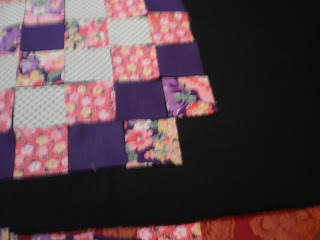Patchwork Sampler.
Before you begin.
Over the next few pages we will look at some of the equipment you may need to commence your patchwork journey. There are some basic equipment needs that are musts while others you can add to as you progress.
1/ Sewing Machine: A basic sewing machine is all on needs if you decide to machine sew your quilts. The major requirement of your machine is that it does straight stitch. It would also be helpful when you come to quilt your quilt that the machine can accomadate a walking foot or alternatively can drop the feed dogs and utilize a darning foot.
To view needles for your sewing machine click on the following link http://www.craftgate.com.au/products/Packet-of-Assorted-Universal-Machine-Needles.html
2/ Thread: Many quilters prefer to use a good quality cotton thread in the sewing machine and for the hand quilting process. Thou a good quality polyester-cotton thread can also be utilized. The colour of the thread used is important, try to match the thread colour to the fabric colour. If using a variety of coloured fabrics match the darkest colour fabric with your thread. To view thread range please click on the following link http://www.craftgate.com.au/categories/Threads/Gutermann-Threads/
3/Pins: These will assist in holding the various pieces of fabric together until machine sewn. It is fine to use smaller, fine pins for this process and the longer Quilting pins when pinning the 3 layers, quilt top & wadding & backing, together. To view our range of pins please click on the following link http://www.craftgate.com.au/categories/Haberdashery/Needles-and-Pins/
4/Rotary Cutters: Rotary Cutters make cutting your fabric, especially when cutting multiple layers, a lot easier and very accurate. There are a variety of cutters on the market and it really is a case of trying the different ones available i.e if possible try out your fellow patchworkers, cutters before buying a expensive one. Besides a wide range of styles there is also a variety of sizes, 45mm is the most utilized size. When using a rotary cutter a Quilters Ruler should always be utilized as well. The depth of the quilters ruler ensures the rotary cutter is less likely to stray and cut fingers. To view our range of rotary cutters please click on the following link http://www.craftgate.com.au/categories/Scissors-And-Rotary-Cutters/
5/ Cutting Mats: These mats are specially designed to be used with the rotary cutter. They are often referred to as self healing in that if marked by the rotary cutter the mark will disappear. Don’t use other types of cutting tools on this mat as they will permantly mark these mats. Also never leave your mat in a hot car as once these mats buckle it can never be reversed thus rendering the mat useless. A good sized cutting mat to start off with is 23in x 17in.
6/Quilters Rulers: A quilters ruler is made of, usually, clear acrylic. This allows the user to see the fabric to be cut clearly and thus cut straight lines everytime. As there are many diff sized rulers available a good size to start with is 14in x 4 1/2in. The markings on the ruler should include 1/4in markings and 45 and 60 degree angle markings.
6/ Scissors: A good pair of fabric cutting with sharp points and another pair for cutting paper. To view our range of scissors please click on the following link http://www.craftgate.com.au/categories/Scissors-And-Rotary-Cutters/
7/Fabric: Many quilters utilize 100% cotton for their projects due to its softness, tightness of weave thus not a fabric that distorts its shape easily and the straightness of the grain due to its tighter weave.
Preparation Of Fabric: Many quilters prefer to pre wash their fabric prior to use as this pre shrinks the fabric and rids the fabric of any loose dye.
Selecting Fabric: When choosing fabric for a sampler quilt l tend to choose my main fabric first. The main fabric is usually a busy print. From this fabric l will identify approx 3 colours within the design and choose fabrics of a less busy nature of those 3 colours. These three colours/fabrics become your support colours. The final fabric to choose is your background colour, this colour is pale, of one tone or a tone on tone. This fabric recedes into the background when viewing the completed quilt.
Fabric Amounts: This is a rough estimate only for a lap quilt i.e. 12 blocks, 12inchs x 12 inches. Main Fabric and Background Fabric each 1 1/2 yards or 140cms, Support Fabrics x 4, 4 fat quarters.













































